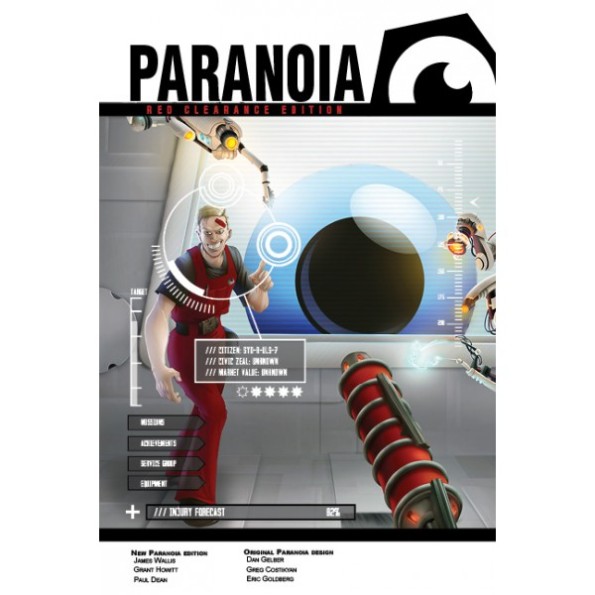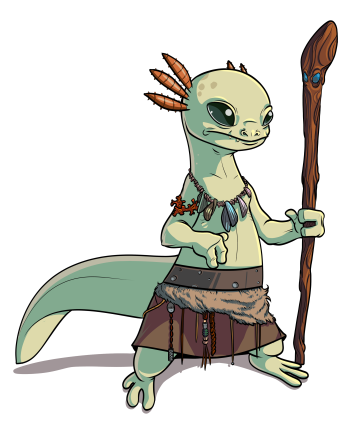Archive
HAPPINESS IS MANDATORY; A review of Mongoose’s new take on the Paranoia RPG

Paranoia has been around for decades, and is a game I was in love with 20 years ago. Recently, I picked up and read (cover to cover) Mongoose’s take on life in our beloved Alpha Complex, and found that not only was happiness mandatory, but it was pretty darn easy to comply.
If you’ve never seen the game before, Paranoia is a darkly humorous RPG where you play a citizen of Alpha Complex, a sealed vast complex of various sectors built to survive some great calamity. Alpha Complex is controlled by The Computer, a semi-omnipotent semi-insane artificial intelligence that has, over hundreds of cycles of operation, turned Alpha Complex into an Orwellian witch hunt for commies, mutants, and members of secret societies. Traditionally, you play a faithful troubleshooter just above the minimum security clearance level, who also happens to be a mutant and a member of a secret society. You have six clones (because a computer knows something about backups), and death comes easily. Most games typically involve hunting each other, incriminating yourself, hunting threats to the complex, and getting blown up in a variety of dramatic hilarious ways, from simple R&D product testing to actual threats.
Mongoose has done little to change this classic formula thematically, but has done a great job of sprucing up the rules and play of the game to match the character the game has always carried with it. Here are the primary changes for long time players:
- Cards have been added to make equipment and duties easier to keep track of, and have created action cards you can use add story elements or interrupt another players action to make things interesting. Since screwing over the guy sitting next to you is half the fun, it makes for creative fast paced play.
- Skills are tested by rolling dice and tracking 5’s or 6’s (with all rolls of 1-4 taking away a success if the player has a negative skill number, or being ignored with a positive skill number). Players are encouraged to make creative combinations of their four Stats (Violence, Brains, Chutzpah and Mechanical) and a large list of skills.
- Along with your skill dice, you roll a “Computer Dice” (they say Dice because the word ‘die’ is used too much already in the book). Rolling a Computer on the Computer Dice forces a player to lose “Moxie” (your ability to cope) and represents either equipment malfunction or the Computer’s helpful interference pushing the player closer and closer to the breaking point. Run out of Moxie and you lose it in the way that is funniest at the time.
- Commies are now termed the more generic “terrorists” (though you still can and do have commie terrorists, so that’s pretty much the same.
- All characters are implanted at birth with a Cerebral Cortech and cyber-eyes which allow the computer to beam programs straight into the character’s brain, as well as video treason with the characters own eyes as witnesses for (or against) them.
- Players now perceive in augmented reality, with name tags and “treason stars” floating above other players. 5 stars and you’re laser fodder.
- Players are awarded “XP Points” by the Computer for positive actions and behavior, and are docked XP Points for negative or treasonous behavior. XP Points can be used to buy skill and stat upgrades, software packages, and security clearance upgrades, complete with cake to celebrate with.

I won’t get into some of the rules that the GM uses, as they are above your security clearance, but I’ll summarize by saying that they remain fast and loose, and easy for any GM to apply. The players often times end up making things more interesting than the GM could ever manage through attempts at creative problem solving.
Overall, Mongoose’s take on the game emphasizes creativity and minimizes mechanics, which really has always matched the particular play style of this game. You don’ win Paranoia, you survive it.
The main box comes with five dry erase character sheets, a players book, a GM book (which made me laugh out loud reading it several times), and book with three adventures in it that start off with the players at infrared status (minimum security status) and moving their way up, learning alpha complex as you go. It’s a great series of adventures because it presumes no knowledge of the system and lets players learn. It also is written in such a way that the GM can read that first and run the game before reading the rules. It’s pretty amazing and a great way to jump right in.
Pick this game up if your friends can enjoy sabotaging each other with hilarious consequences and you’re a GM capable of thinking on your feet to make things fun. It’s a great change of pace from the same old fantasy game and makes for a great one shot in between campaign sessions.

Creature Feature: The Xalot
Today’s creature feature is the mild-mannered Xalot. Can be used for either DCC or MCC, and if you are intrigued by this little dude here, please check out “Where The Drowned God Dwells” an MCC adventure I will be running (twice!) at this year’s GenCon.
Xalot: (4-5 if foraging party; 30 to 40 adults plus one Elder and juveniles in tribal village); Init +1 on land, +3 in water; Atk Staff +1 melee (1d6) and/or net +2 ranged (entangle); AC 12; HD 1d8+1; hp 6; MV 30’ land, 60’ swim; Act 1d20; SP: amphibious, infravision (underwater only); SV Fort +1, Ref +1, Will +0; AL N.

The Xalot people are generally peaceful and form medium-sized colonies of 40 to 50 adults with a single Elder and many younglings at any given time, depending on the season. Short in stature, they stand roughly the size of a halfling and have cool, moist skin in a variety of colors and patterns. Xalots also have a limited ability to alter their color to provide better camouflage while out hunting or foraging.
Elders are slightly larger than the typical xalot and possess a passive telepathic empathy with which they can communicate danger or strong feelings with their own people and outsiders. Elders are also rumored to have some small ability with magic as well.
Most xalot are inquisitive and fearless, which makes them easy prey for predators. They are natural explorers, however, especially of the deep seas as they forage for food. Although they do make their own crude items for everyday life, skilled craftsmen and artisans they are not. They also willingly trade goods they find on their explorations with nearby peoples who treat them well. They have their own language, a sibilant tongue that incorporates the flaring of the gill stalks which sprout from the sides of their heads, and most also speak the dominant language of whatever region they find themselves in.
Typically nomadic, a Xalot colony will migrate every few years to an abandoned coastal area to perform their mating rituals and lay copious amounts of eggs before moving on. The first egg, thereafter called the Elder, hatches and quickly matures much more rapidly than the first wave, acting as a lookout and guarding over the second wave, until the final wave hatches… thereby forming a new colony within the space of a year or two.
Xalot Elder: Init +1 on land, +3 in water; Atk Staff +2 melee (1d6+1) and/or net +3 ranged (entangle); AC 14; HD 1d8+3; hp 8; MV 30’ land, 60’ swim; Act 1d20; SP: amphibious, infravision (underwater only), telepathic empathy (120′), spells: water breathing and mending, others as desired (d20+4); SV Fort +1, Ref +1, Will +2; AL N.


 DnD Blogs
DnD Blogs Game Night
Game Night NaGa DeMon
NaGa DeMon RPGBA
RPGBA
You must be logged in to post a comment.